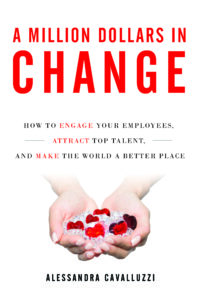Change the World
Charitable giving programs are taking off as more and more organizations realize that social responsibility is important to customers, employees, and communities.
But how do you start one? And is it really possible to change the world one company at a time?
Alessandra Cavalluzzi is someone who has made an enormous impact creating these programs and encouraging others to start them. She currently oversees corporate giving and fundraising for a large company. Her new book, A Million Dollars in Change: How to Engage Your Employees, Attract Top Talent, and Make the World A Better Place.
I recently spoke with her about her passion for corporate giving.
Would you clarify the difference between charitable giving and a corporate social responsibility program?
Charitable giving and corporate social responsibility are often used interchangeably. However, we’ll sometimes see articles and books describe them as being completely different animals. The truth is, they are not exclusive of each other, but they are a little bit different. Charitable giving encompasses donations or grants made to a nonprofit organization. If you’ve ever made a donation to fund cancer research, for instance, this is a form of charitable giving.
Corporate social responsibility (CSR) can include philanthropy, but these programs have other functions, too. A company might design a CSR program, for instance, to improve the well-being of its employees, the environment, and the community around it. A company with a CSR program might partner with a nonprofit to keep at-risk teens in school by enrolling them in training and educational programs. Companies with CSR programs encourage volunteerism, their employees volunteer their time and talent to help a local nonprofit. It’s not uncommon for a company with a CSR program to reduce its carbon footprint by making changes like installing solar panels or energy efficient lighting, or doing away with Styrofoam in its packaging. All of these are examples of CSR.
The main thing to remember is that both charitable giving and corporate social responsibility are important. A company doesn’t need to adopt one over the other. Which term you use to describe your program will depend on whether you decide to go strictly with philanthropy, create a full CSR plan, or maybe even develop a hybrid—donations plus action. It’s really up to the company. The bottom line is, there is no “wrong way” to give.
3 Myths of Corporate Giving and CSR Programs
What are some of the myths surrounding corporate giving and CSR programs?
There are many, but the three that I’ve heard repeated often over the years are:
- CSR is a “nice to have,” but it’s not a “need to have” because it doesn’t impact a company’s core strategy execution.
- There’s no tangible return on investment (ROI) associated with workplace giving and/or CSR programs.
- You need to invest a lot of money in a workplace giving program to do it right.
All three of these statements are patently false, and I debunk each of these myths in my book. In fact, myth #3 was really at the heart of the reason why I wrote “A Million Dollars In Change.” But I want to touch on all three here because it’s important. Let’s start with CSR’s relationship with impacting core execution. Studies show that employees expect companies to provide them with an effective workplace giving program and opportunities to volunteer during work hours – particularly in skills-based volunteering. It’s important to take note of this, especially from an employee engagement perspective. Embedding a strategy for social good into your company’s business strategy helps strengthen employees’ emotional commitment and increases the emotional investment employees make in your company. If you take it even further and give employees a voice, inviting them to offer ideas and feedback about your program on a regular basis, you are also empowering them. Empowerment is a great motivator and driver of engagement. Engagement and empowerment contribute to higher performance, which in turn leads to higher productivity. Employee performance and productivity levels have a direct impact on successful core strategy execution. So, in this way, CSR absolutely has an impact on core execution.
Regarding the second myth around the ROI, or lack of it, with workplace giving and/or CSR we need to look beyond the tangible evidence. Hard to do, I know, because in business we are trained to measure success by “numbers”; but consider that corporate giving plays a critical role in how your company is perceived by all of your stakeholders, which without a doubt impacts your ROI. Remember also, that your employees are your company’s biggest ambassadors. Through volunteerism they help raise the visibility of your brand and also strengthen your reputation as a good corporate citizen. Your employees are your corporate culture in action.
If your company, like many others, is struggling to engage your millennial workforce and/or appeal to millennial consumers, you should know that a report sponsored by the Case Foundation with research from Achieve found that millennials expect corporations and employers to be committed to doing good. This group will make up roughly fifty percent of the workforce by 2020, so it’s more important than ever that companies weave giving into their business strategies. Another example is The Case Foundation’s Millennial Impact Report, which noted that company-sponsored cause work is a big selling point if you hope to attract talented, civic-minded millennials. Employee retention, recruitment, engagement, enhanced company reputation, and increased brand visibility. I’d say that’s an excellent return on investment!
The last statement, or myth, is the one I hear most often as the reason many companies don’t have a charitable giving or CSR program. Many believe that you have to make a significant dollar investment to launch a program, or to do it “right.” As I said earlier, there is no “wrong way” to give. There are many examples of ways that companies of all sizes are making a difference via the case studies I provide in my book. For example, many events, such as clothing and food drives, cost your company nothing and still benefit nonprofits and the people they serve – while engaging your employees at the same time. Organizing a volunteer effort is also a no- or low-cost activity. Starting your program off with these types of events has other benefits as well. It gives you an opportunity to gauge employee interest, and allows you to gather data to build a case for future funding and program expansion. You don’t need to spend a million dollars to make an impactful difference in your community. Doing something beats doing nothing any day.
Benefits of Corporate Giving Programs
You’ve seen the benefits of these programs from many sides. Share with us some of the benefits you’ve seen firsthand.
From an employee perspective, the engagement via volunteerism and company-wide activities such as fundraisers and matching gifts is amazing. I’ve received feedback from employees expressing their pride in the company they work for. Others reach out to express their gratitude in being given the opportunity to volunteer during work hours to make a difference in their communities. Employees also appreciate having a voice in program activities, and they provide feedback and suggestions on an ongoing basis. A company that is socially responsible and a strong advocate of community involvement will have higher levels of engagement than companies that are not actively supporting the communities where they live and work.
Volunteerism promotes teamwork and allows employees from different areas in the company and different levels to work together to make a difference in the lives of others. Individual contributors may find themselves working side by side with the CFO on a community service project. That’s an incredible morale boost. From senior leadership’s perspective, it’s an opportunity to get to know their teams on a more personal level outside of their work roles. This goes a long way in forging relationships and building trust between senior leadership and employees.
Nonprofits appreciate the support and especially the extra “hands” via volunteers. Hiring consultants and outside staff is very expensive and often not possible for organizations focused on serving the community and furthering their missions. That’s where skills-based volunteering can really make a difference. Countless numbers of individuals in our communities rely on the services and programs provided by our nonprofits. Donating expertise and services to nonprofits pro-bono goes a long way in helping them to achieve their mission and goals.
Know Your Why
Why is learning more about your company’s “why” so important?
Knowing your company is more than just knowing what types of products you manufacture or sell, what kind of services you offer, or the benefit plan your employees receive. What you need to know is your company’s purpose, its reason for existing. The reason it’s so important to begin with understanding your company’s purpose is because your charitable giving or CSR program’s strategy will need to be aligned with your company’s business strategy in order for you to create measurable and sustainable impact in your community. It’s also important to successfully gain your leadership’s buy-in for your plan. Leadership’s support is critical. You’ll want them to be actively involved in supporting company-sponsored events, volunteer efforts, and fundraisers. Executive support and participation is key in motivating your employees to get involved. Senior executive leadership’s involvement and support also shows the community that your company walks the walk. Finally, tying your program’s purpose to your company’s “why” helps employees make the connection between business and social strategy and how they are contributing to something bigger than just the company’s bottom line.
When and how did this mission take hold in your career and life?

Thirteen years ago, I had a vision. I wanted to take my company’s charitable giving program to the next level, and I wanted this bigger and better program to make our employees proud, attract the best people to our company, and help others in the process. I wanted to combine charitable giving with opportunities for our employees to be hands-on agents of change. I had ideas for working with nonprofits to help solve issues that our communities face such as homelessness, veteran unemployment, illiteracy, and poverty. I knew what I wanted to do. I just had to figure out how to do it. I began searching online for information on how to develop and implement a corporate giving program, but all I could find was data on why it was critical for companies to adopt giving or CSR as part of their strategy. I came across plenty of great articles and reports that talked about the benefits of having a CSR program and the consequences of not adopting a CSR strategy as part of a business strategy. I read all about “social investing” and “social enterprise.” But for someone starting from square one, I found this information to be too complex and completely overwhelming. I realized soon enough that I was pretty much on my own. I thought about abandoning my plan many times. I thought, “I could just forget this idea, or, I could take a chance and try to do this myself.” In the end I decided on the latter, and I set out to develop a plan to build a workplace giving program for my company. These days I’m the Director of Community Relations at a multi-billion-dollar company, and I often speak on this topic at HR and business events, and I participate on panels about the benefits of corporate giving and CSR programs. I’ve advised many nonprofits and corporate funders over the years; the latter reach out for advice on how to begin a program at their company. What started as a journey to create a program at my company led to the creation of a department and a new career path for me. People often say to me, “You have the best job.” They’re right!
After you launch a program, how do you make it stick?
I love this question because it can really be applied to any type of program or initiative you launch in your company. The reason I say that is because it involves change. It’s important to remember that even good change is still change, and any change is going to be met with a bit of skepticism and, sometimes, resistance from your employees. The key to making change stick is communication – lots of it – and reinforcement of the message you are sending. When it comes to community involvement, there are a few ways to accomplish this. Certainly, communicating via your company’s Intranet or department meetings are some ways to keep employees engaged. Regular e-mail blasts are another way. But what I’ve found to be the most effective means in keeping the momentum going is having company ambassadors for your program. Communicating your vision, expectations, and desired outcomes to everyone involved in the process builds trust and keeps rumors at bay, and this is key to employees embracing your program and the changes that come with it. It’s also the key to making those changes stick. The community ambassadors (or whatever name you choose for them) are the people who will assist you in spreading your message and reinforcing your program’s mission across your company. They’ll also provide you with feedback on what your employees are thinking and feeling with regard to your program. It is a big responsibility, one that requires people who are strong believers in your mission and truly passionate about the cause. This is why it is important to choose people who are recognized as leaders by their peers. They don’t have to have leadership titles, but they do need to embrace your company culture and your program’s purpose. This group will be instrumental in driving employee participation in your program and in helping employees make the connection between your company’s business and social strategies. More important, they help employees understand the role that each individual plays in helping your program support the communities where we live and work.
How have you dealt with the resistors and critics who fight what you’re doing?
 I wouldn’t call them resistors as much as people who have bought into the myths I described earlier. Many business leaders and HR professionals have told me over the years that they want to launch a charitable giving or CSR program in their company, but they feel intimidated and don’t know where to begin. I’ve been approached by people who have told me that they want to embed the values of service and community into their organization, but they fear they will come up against resistance, either from employees or management. Others have worried they are “just one voice” and don’t think that they’ll be taken seriously. People in general want to do good, give back, and help others. What I tell them is start small, but start, and remember that it’s a journey. One of my favorite quotes is from Lao Tzu and says, “Great acts are made up of small deeds”.
I wouldn’t call them resistors as much as people who have bought into the myths I described earlier. Many business leaders and HR professionals have told me over the years that they want to launch a charitable giving or CSR program in their company, but they feel intimidated and don’t know where to begin. I’ve been approached by people who have told me that they want to embed the values of service and community into their organization, but they fear they will come up against resistance, either from employees or management. Others have worried they are “just one voice” and don’t think that they’ll be taken seriously. People in general want to do good, give back, and help others. What I tell them is start small, but start, and remember that it’s a journey. One of my favorite quotes is from Lao Tzu and says, “Great acts are made up of small deeds”.
It doesn’t matter what language you speak or which continent you’re on. The program you design will be successful because at its very core will be your desire to help others and make the world a better place. You might not realize it now, but that desire is universal.
For more information, see A Million Dollars in Change: How to Engage Your Employees, Attract Top Talent, and Make the World A Better Place.

